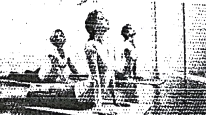题目内容
【题目】
The Sculptor Speaks
Appreciation of sculpture depends upon the ability to respond to form in three dimensions(维度). That is perhaps why sculpture has been described as the most difficult of all arts; certainly it is more difficult than the arts which involve 【1】 of flat forms, shape in only two dimensions. Many more people are ‘form-blind’ than color-blind. Children learning to see, first distinguishes only two-dimensional shape; it cannot judge distances, depths. Later, for their personal safety and practical needs, they have to develop partly by 【2】 of touch, the ability to judge roughly three-dimensional distances. But after they 【3】 the requirements of practical necessity, most people go no further. Though they may 【4】 considerable accuracy in the perception(知觉,感知) of flat form, they do not make the further intellectual and emotional effort needed to 【5】 form in its full spatial existence.
This is what the sculptor must do. He must 【6】 continually to think of, and use, form in its full spatial completeness. He gets the solid shape, as it were, inside his head—he thinks of it, whatever its size, as if he were holding it completely in the hollow of his hand. He 【7】 visualizes a complex form from all round itself; he knows while he looks at one side what the other side is like, he will have to 【8】 himself with its centre of gravity, its mass, its weight; and he realizes its volume, as the space that the shape displaces in the air.
And the sensitive observer of sculpture must also learn to feel shape simply as 【9】, not as description or reminiscence(回忆,联想). He must, for example, see an egg as a simple single solid shape, quite apart from its significance as food, or from the 【10】 idea that it will become a bird. And so with solids such as a shell, a nut, a plum, a pear, a tadpole, a mushroom, a mountain peak, a kidney, a carrot, a tree-trunk, a bird, a bud, a lark, a ladybird, a bulrush, a bone. From these he can go on to appreciate more complex forms of combinations of several forms.
【答案】
【1】AC
【2】AD
【3】B
【4】ABC
【5】AB
【6】BD
【7】C
【8】CD
【9】D
【10】A
【解析】
这是一篇说明文。文章讲述了雕塑家三维的思维模式,雕塑家需要在自己的思维中训练自己对物体的重量、体积等等数据的判断。同时,在他看到一些事物的时候也会想象这些事物的线条等等。
【1】考查名词。appreciation:欣赏。句意:当然,这比欣赏平面艺术更难。前文中提到雕塑是非常难的,因为雕塑是考验三维空间的能力,而平面艺术只是二维的,因此比欣赏平面艺术更难,故选AC。
【2】考查名词。means:方式。句意:后来,为了他们的人身安全和实际需要,他们不得不通过触摸来发展、判断大致三维距离的能力。此处为固定搭配,by means of意为“用……,依靠,借助于”。故选AD。
【3】考查动词。satisfy:使满意、使满足。句意:但是,在满足实际需要的要求后,大多数人不再往前走。很多人不再继续提升,说明他们对自己现阶段的情况表示满意,即满足了他们的要求。故选B。
【4】考查动词。acquire:获得。句意:虽然他们在对平面形态的感知方面可能获得相当的准确性。在平面状态下也可建立一些认知,故选ABC。
【5】考查动词。comprehend:理解、领悟。句意:他们不做进一步的智力和情感上的努力,以领悟该形式在其完整的空间存在。分析文章可知,三维空间的能力除了能在平面状态下获得准确的感知,但能够在空间状态的下领悟到物体的形式也非常重要。故选AB。
【6】考查动词。strive:努力、奋斗。句意:他必须不断努力去思考和使用以形成完整的空间完整性。文章第二段第一句提到“This is what the sculptor must do”一些雕塑家必须要做的事,即除了获得平面认知外,也要锻炼自己空间想象的能力。故选BD。
【7】考查副词。mentally:精神上地。句意:他根据周围情况本身在精神上形象化了一个复杂的形式。该段第二句提到“He gets the solid shape, as it were, inside his head”,当他看到一个固体的时候,他就会在脑海中形成这个物体的形状。即雕塑家会在自己的印象中呈现这个形式。故选C。
【8】考查动词。identity:认同、辨认、确认。句意:他会把自己当作重心、质量、重量…。identity with为固定搭配,意为“认同、认为…等同于、与…认同”。故选CD。
【9】考查名词。shape:形状。句意:雕塑的敏感观察者也必须学会简单地把形状感觉成形状,而不是描述或回忆。as意为像、如同,最后一段第一句提到“…not as description or reminiscence”,雕塑家不要对物体进行回想或描述,说明只需要简单的看待物体即可。故选D。
【10】考查名词。literary:文学的。句意:他必须把鸡蛋看陈一个简单的固体形状,除了它作为食物的意义,或者从文学的想法,把它变成一只鸟。分析文章可知,从一个固定的形状到联想到其发展的意义,是一种比较文艺、文学的做法。故选A。

 期末集结号系列答案
期末集结号系列答案
